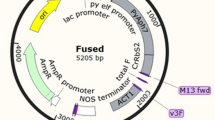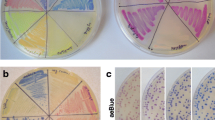Abstract
Plastocyanin can be detected in Synechocystis sp. PCC 6803 when 3 μM copper is added to the growth medium, BG-11. The plastocyanin gene (petE) was cloned from a genomic λ EMBL 3 library by screening with the petE gene from Anabaena sp. PCC 7937. The Synechocystis 6803 petE gene is present as a single copy and, as deduced from the DNA sequence, encodes a precursor protein of 126 amino acids. The predicted 29 amino acid transit peptide shows substantial homology to the Anabaena 7937 transit peptide, thought to direct the plastocyanin precursor to the thylakoid lumen. Putative promoter sites −16 and −38 base pairs from the start of the petE gene have been identified. The deduced amino acid sequence has the greatest homology (61%) to the green alga Scenedemus obliquus plastocyanin. Despite the lower homology, the copper binding residues and certain aromatic residues remain highly conserved. Northern hybridization analysis indicates that the Synechocystis sp. PCC 6803 petE gene is not transcriptionally regulated since the accumulation of petE mRNA appears to be independent of the copper concentration in the growth media. The possibility of an additional polypeptide needed to facilitate the electron transfer from plastocyanin to P700+ is also discussed.
Similar content being viewed by others
References
Bengis C, Nelson N: Subunit structure of chloroplast photosystem I reaction center. J Biol Chem 252: 4564–4569 (1977).
Beoku-Betts D, Chapman SK, Knox CV, Sykes AG: Concerning the binding site on plastocyanin for its natural redox partner cytochrome f. J Chem Soc Chem Commun 767: 1150–1152 (1983).
Blake MS, Johnston KH, Russell-Jones GJ, Gotschlich EC: A rapid, sensitive method for detection of alkaline phosphatase-conjugated anti-antibody on western blots. Anal Biochem 136: 175–179 (1984).
Blattner FR, Williams BG, Blechl AE, Denniston-Thompson K, Farber HE, Furlong L, Grunwald DJ, Kiefer DO, Moore DD, Schumm JW, Sheldon EL, Smithies O: Charon phages: safer derivatives of bacteriophage lambda for DNA cloning. Science 196: 161–169 (1977).
Cantrell A, Bryant DA: Molecular cloning and nucleotide sequence of the psaA and psaB genes of the cyanobacterium Synechococcus sp PCC 7002. Plant Mol Biol 9: 453–468 (1987).
Debus RJ, Barry BA, Babcock GT, McIntosh L: Site-directed mutagenesis identifies a tyrosine radical involved in the photosynthetic oxygen-evolving system. Proc Natl Acad Sci USA 85: 427–430 (1988).
Devereux J, Haeberli P, Smithies O: A comprehensive set of sequence analysis programs for the VAX. Nucl Acids Res 12: 387–395 (1984).
Farver O, Shahak Y, Pecht I: Electron uptake and delivery sites on plastocyanin in its reaction with the photosynthetic electron transport system. Biochemistry 21: 1885–1890 (1982).
Feinberg AP, Vogelstein B: A technique for radiolabelling DNA restriction endonuclease fragments to high specific activity. Anal Biochem 132: 6–13 (1984).
Golden SS, Brusslan J, Haselkorn R: Genetic engineering of the cyanobacterial chromosome. Meth Enzymol 153: 215–231 (1987).
Guss JM, Freeman HC: Structure of oxidized poplar plastocyanin at 1.6 Å resolution. J Mol Biol 169: 521–563 (1983).
Ho KK, Krogman DW: Electron donors to P700 in cyanobacteria and alga: an instance of unusual genetic variability. Biochim Biophys Acta 766: 310–316 (1984).
Hutber GN, Hutson KG, Rogers LJ: Effects of iron deficiency on levels of two ferrodoxins and flavodoxin in Cyanobacterium. FEMS Microbiol Lett 1: 193–196 (1977).
Kelly J, Ambler RP: The amino acid sequence of plastocyanin from Chlorella fusca. Biochem J 143: 681–690 (1974).
Kwok KH, Ulrich EL, Krogman DW, Gomez-Lojero C: Isolation of photosynthetic catalysts from cyanobacteria. Biochim Biophys Acta 545: 237–249 (1979).
Lowry OH, Rosebrough NJ, Farr LA, Randall RJ: Protein measurement with the folin phenol reagent. J Biol Chem 193: 265–274 (1951).
Maniatis T, Fritsch EF, Sambrook J: Molecular Cloning: A Laboratory Manual. Cold Spring Harbor Laboratory, Cold Spring Harbor (1982).
Maxam AM, Gilbert W: Sequencing end-labeled DNA with base-specific chemical cleavages. Meth Enzymol 65: 499–560 (1980).
Merchant S, Bogorad L: Rapid degradation of apoplastocyanin in Cu(II) deficient cells of Chlamydomonas reinhardtii. J Biol Chem 261: 15850–15853 (1986).
Merchant S, Bogorad L: Metal ion regulated gene expression: use of plastocyaninless mutant of Chlamydomonas reinhardtii to study the Cu(II) dependent expression of cytochrome c-552. EMBO J 6: 2531–2535 (1987).
Moore JM, Chazin WJ, Powls R, Wright PE: 1H NMR studies of plastocyanin from Scenedesmus obliquus: complete sequence-specific assignment, secondary structure analysis, and global fold. Biochemistry 27: 7806–7816 (1988).
Mordhay A, Shneyour A: On the site of action of plastocyanin in isolated chloroplasts. Biochim Biophys Acta 226: 498–500 (1971).
Ramshaw JAM, Brown RH, Seawen MD, Boulter D: Higher plant plastocyanin. Biochim Biophys Acta 303: 269–273 (1972).
Rippka R, Deruelles J, Waterbury JB, Herdman M, Stanier RY: Generic assignments, strain histories and properties of pure cultures of cyanobacteria. J Gen Microbiol 111: 1–61 (1979).
Rother D, Jansen T, Tyagi A, Tittgen J, Hermann RG: Plastocyanin is encoded by an uninterrupted nuclear gene in spinach. Curr Genet 11: 171–176 (1986).
Sandmann G: Formation of plastocyanin and cytochrome c553 in different species of blue-green algae. Arch Microbiol 145: 76–79 (1986).
Sanger F, Coulson AR, Barrel BG, Smith AJ, Roe BA: Cloning in single-stranded bacteriophage as an aid to rapid DNA sequencing. J Mol Biol 143: 161–178 (1980).
Simpson RJ, Moritz RL, Nice EC, Grego B, Yoshizaki F, Sugimura Y, Freeman HC, Murata M: Complete amino-acid sequence of plastocyanin from a green alga, Enteromorpha prolifera. Eur J Biochem 137: 497–505 (1986).
Smeekens S, Bauerle C, Hageman J, Keegstra D, Weisbeek P: The role of the transit peptide in the routing of precursors toward different chloroplast compartments. Cell 46: 365–376 (1986).
Smeekens S, de Groot M, van Binsbergen J, Weisbeek P: Sequence of the precursor of the chloroplast thylakoid lumen protein plastocyanin. Nature 317: 456–458 (1985).
Smeekens S, Weisbeek P: Protein transport towards the thylakoid lumen: posttranslational translocation in tandem. Phtosynth Res 16: 177–186 (1988).
Southern EM: Detection of specific sequences among DNA fragments separated by gel electrophoresis. J Mol Biol 98: 503–517 (1975).
Towbin H, Stahelin T, Gordon J: Electrophoretic transfer of proteins from polyacrylamide gels to nitrocellulose sheets. Proc Natl Acad Sci USA 76: 4350–4354 (1979).
Vaitukaitis JL: Production of antisera with small doses of immunogen: multiple intradermal injections. Meth Enzymol 73: 46–52 (1981).
Van der Plas J, Bovy A, Kruyt F, de Vrieze G, Dassne E, Klein B, Weisbeek P: The gene for the precursor of plastocyanin from the cyanobacterium Anabaena sp. PCC7937: isolation, sequence and regulation. Mol Microbiol 3: 275–284 (1989).
Van der Plas J, de Groot R, Woortman M, Cremers J, Borrias M, van Arkel G, Weisbeek P: Genes encoding ferredoxins from Anabaena sp. PCC 7937 and Synechococcus sp PCC 7942: structure and regulation. Photosynth Res 18: 179–204 (1988).
Wessels JSC: Isolation of a chloroplast fragment with NADP+-photoreducing activity dependent of plastocyanin and independent of cytochrome f. Biochim Biophys Acta 126: 581–583 (1966).
Williams JGK: Construction of specific mutations in photosystem II photosynthetic reaction center by genetic engineering methods in Synechocystis 6803. Meth Enzymol 167: 766–778 (1988).
Wynn RM, Malkin R: Interaction of plastocyanin with PS I: a chemical cross-linking study of the polypeptide that binds plastocyanin. Biochemistry 27: 5863–5869 (1988).
Author information
Authors and Affiliations
Rights and permissions
About this article
Cite this article
Briggs, L.M., Pecoraro, V.L. & McIntosh, L. Copper-induced expression, cloning, and regulatory studies of the plastocyanin gene from the cyanobacterium Synechocystis sp. PCC 6803. Plant Mol Biol 15, 633–642 (1990). https://doi.org/10.1007/BF00017837
Received:
Accepted:
Issue Date:
DOI: https://doi.org/10.1007/BF00017837




